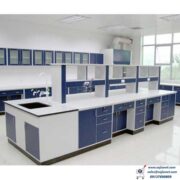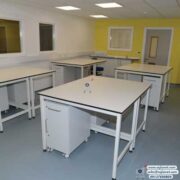Laboratory furniture is specially designed furniture that is used in laboratories for conducting experiments, research, and other scientific activities. The furniture used in laboratories needs to be sturdy, durable, and able to withstand the harsh environment of a laboratory.
There are various types of laboratory furniture, each with its own purpose and design. Some of the most common types of laboratory furniture include:
- Laboratory benches and tables – These are the most basic type of laboratory furniture and are used to hold equipment, samples, and other materials during experiments. They are typically made of materials that are resistant to chemicals and other harsh substances commonly found in laboratories.
- Laboratory cabinets and storage units – These are used to store laboratory equipment and materials safely and securely. They are designed to be resistant to spills and leaks, and often feature lockable doors for added security.
- Laboratory fume hoods – These are large, enclosed structures that are used to contain and exhaust harmful chemicals, vapors, and fumes generated during laboratory experiments. They help protect laboratory workers from exposure to hazardous materials.
- Laboratory chairs and stools – These are designed to be adjustable and ergonomic, allowing laboratory workers to work comfortably for extended periods of time.
- Laboratory sinks and fixtures – These are used for washing laboratory equipment and materials, and are typically made of stainless steel or other durable materials.
- Laboratory carts and trolleys – These are used to transport laboratory equipment and materials from one location to another.
When choosing laboratory furniture, it is important to consider factors such as the type of experiments and research being conducted, the size and layout of the laboratory, and the budget available. It is also important to choose furniture that is easy to clean and maintain, as hygiene is a critical consideration in laboratory environments.
Overall, laboratory furniture plays a critical role in ensuring that laboratory workers can conduct experiments and research safely and efficiently. It is important to choose furniture that is both functional and durable, in order to create a safe and effective laboratory environment.
Benefits of Laboratory Furniture
Laboratory furniture is specifically designed to meet the unique needs of scientific research facilities, and it offers several benefits, including:
- Functionality: Laboratory furniture is designed to meet the specific needs of the laboratory environment, ensuring that it is practical, functional and efficient.
- Durability: Laboratory furniture is constructed from high-quality materials that are designed to withstand the harsh conditions of a laboratory environment, such as chemicals, heat, and humidity.
- Safety: Laboratory furniture is designed to provide a safe working environment for laboratory staff. It includes features such as chemical-resistant surfaces, fume hoods, and safety cabinets to prevent accidents and reduce the risk of exposure to hazardous materials.
- Ergonomics: Laboratory furniture is designed to be ergonomic, promoting good posture, reducing strain and fatigue, and reducing the risk of musculoskeletal injuries.
- Customization: Laboratory furniture can be customized to meet the specific needs of the laboratory, including size, configuration, and materials used.
- Organization: Laboratory furniture is designed to promote organization and improve workflow, making it easier for laboratory staff to perform their work efficiently and effectively.
- Aesthetics: Laboratory furniture can be aesthetically pleasing, enhancing the overall appearance of the laboratory and creating a positive work environment.
Advantages of Cabinets
Cabinets offer several advantages, including:
- Storage: Cabinets provide storage space for items, helping to keep the area organized and clutter-free. Cabinets can be designed to fit specific items, such as equipment or chemicals, making it easier to locate and access them when needed.
- Security: Cabinets can be locked to provide added security for valuable or hazardous items. This helps to prevent unauthorized access and reduce the risk of theft or misuse.
- Protection: Cabinets can be designed to provide protection for items that require special handling, such as chemicals or sensitive equipment. This helps to prevent damage and ensure that items remain in good working condition.
- Aesthetics: Cabinets can be designed to match the style and decor of the laboratory, enhancing its overall appearance and creating a more cohesive look.
- Customization: Cabinets can be customized to meet the specific needs of the laboratory, including size, configuration, and materials used. This ensures that the cabinets fit seamlessly into the laboratory environment and provide maximum functionality.
- Accessibility: Cabinets can be designed with features such as pull-out shelves or sliding doors to make it easier to access items stored inside. This helps to improve workflow and increase efficiency in the laboratory.
- Organization: Cabinets can be designed with features such as adjustable shelves, dividers, or bins to promote organization and improve workflow. This helps to reduce clutter and make it easier to locate items when needed.
Advantages of Training Stools
- Comfort: Training stools are designed to provide comfort to laboratory staff who may spend long hours working at a laboratory bench or desk. They often feature adjustable height, backrest, and footrest, which can help reduce strain and fatigue.
- Mobility: Training stools are often equipped with casters or wheels, allowing laboratory staff to easily move around the laboratory as needed. This can improve workflow and increase efficiency in the laboratory.
- Stability: Training stools are designed with a stable base that can support the weight of laboratory staff and their work materials. This helps to prevent accidents and reduce the risk of injury.
- Durability: Training stools are constructed from high-quality materials that are designed to withstand the harsh conditions of a laboratory environment, such as chemicals, heat, and humidity. This ensures that the stools last a long time and require minimal maintenance.
- Customization: Training stools can be customized to meet the specific needs of the laboratory, including size, configuration, and materials used. This ensures that the stools fit seamlessly into the laboratory environment and provide maximum functionality.
- Aesthetics: Training stools can be designed to match the style and decor of the laboratory, enhancing its overall appearance and creating a more cohesive look.
- Cost-effectiveness: Training stools are often less expensive than other types of laboratory furniture, such as chairs or benches. This makes them a cost-effective solution for laboratory staff who require comfortable and mobile seating.








